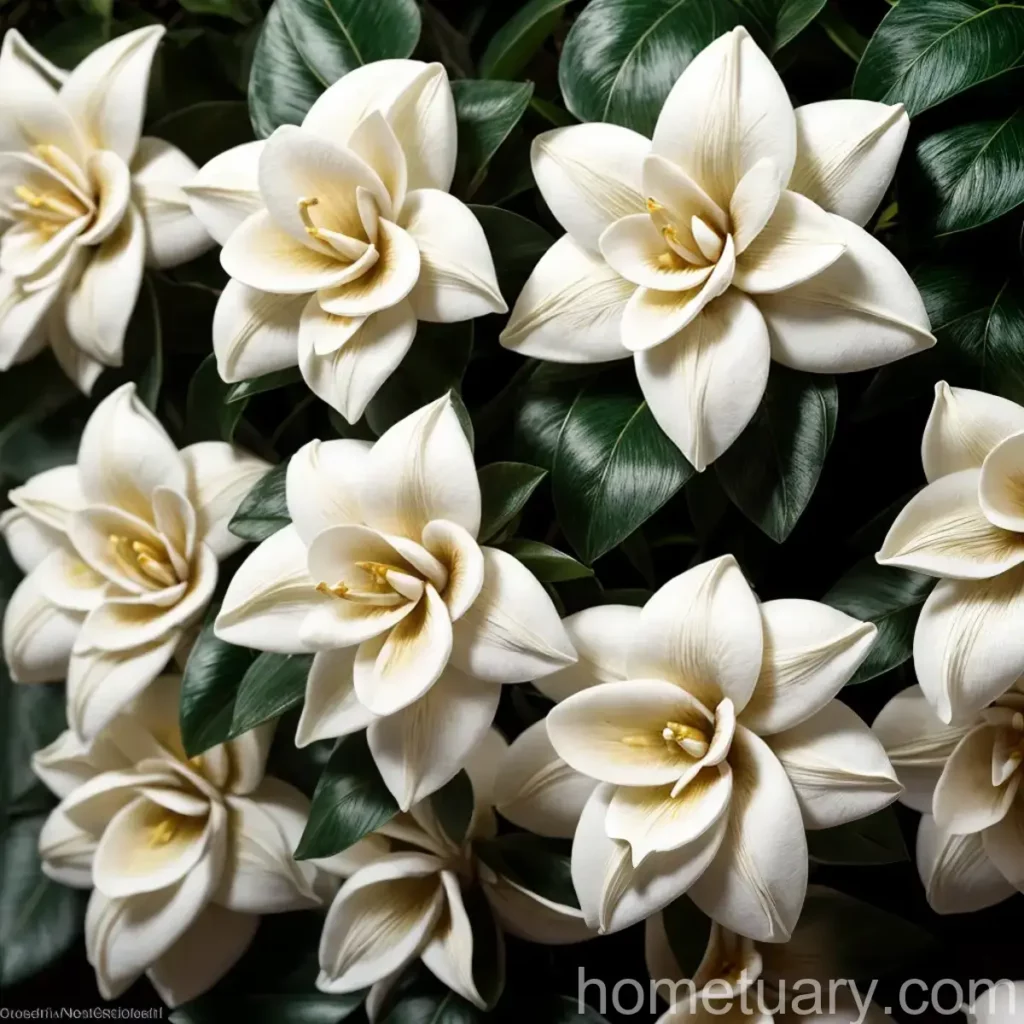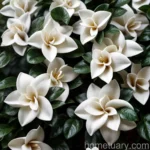The Enigmatic Gardenia (Gardenia jasminoides ‘Radicans Variegata’)
Gardenia jasminoides, commonly known as gardenia, is a beloved and cherished plant in the world of horticulture. Its exquisite fragrance, lush green foliage, and captivating blossoms make it a favorite among garden enthusiasts. Among the many gardenia varieties, Gardenia jasminoides ‘Radicans Variegata’ stands out with its stunning variegated leaves and enchanting flowers. In this comprehensive guide, we will delve into the world of Gardenia jasminoides ‘Radicans Variegata’, exploring its culture, uses, care requirements, and much more.
What is Gardenia jasminoides ‘Radicans Variegata’?
Gardenia jasminoides ‘Radicans Variegata’ is a cultivar of the species Gardenia jasminoides. It is renowned for its variegated foliage, which adds an extra dimension of visual interest to an already captivating plant. This gardenia variety produces classic, fragrant white flowers that are a delight to behold.
The variegation in Gardenia jasminoides ‘Radicans Variegata’ refers to the marbled or mottled pattern on the leaf surface. Variegated leaves often feature a combination of green and a lighter color, such as white or cream, creating a beautiful and unique appearance. This cultivar’s variegation adds a decorative element even when the plant is not in bloom, making it a stunning addition to any garden or indoor space.
Key Takeaways – Gardenia jasminoides ‘Radicans Variegata’
Before we delve into the specifics of caring for Gardenia jasminoides ‘Radicans Variegata’, here are some key takeaways about this captivating plant:
- It is a cultivar of the species Gardenia jasminoides, featuring variegated leaves and fragrant white flowers.
- The variegated foliage adds ornamental value, making it an attractive choice for gardens and indoor spaces.
- Gardenia jasminoides ‘Radicans Variegata’ requires proper cultural practices, including considerations for water, sunlight, fertilizer, soil, and pruning.
- It can be propagated through various methods, allowing for the expansion of its presence in gardens and landscapes.
- Like many plants, it is susceptible to certain diseases and pests, necessitating vigilant care and maintenance.
With these key points in mind, let’s delve deeper into the various aspects of caring for and appreciating Gardenia jasminoides ‘Radicans Variegata’.
Culture
Understanding the cultural needs of Gardenia jasminoides ‘Radicans Variegata’ is essential for ensuring its health and vitality. This encompasses factors such as water requirements, sunlight preferences, fertilizer needs, soil considerations, and pruning practices.
Water
Proper watering is crucial for the well-being of Gardenia jasminoides ‘Radicans Variegata’. While it requires consistent moisture, it is essential to avoid overwatering, which can lead to root rot and other issues. Here are some key points to consider when watering this plant:
- Consistent Moisture: Gardenia jasminoides ‘Radicans Variegata’ prefers slightly acidic and well-draining soil. It is important to maintain consistent moisture levels, ensuring that the soil does not dry out completely between watering sessions.
- Avoid Overhead Watering: When watering, it is advisable to avoid wetting the foliage, as this can contribute to fungal diseases. Direct the water towards the base of the plant to minimize moisture on the leaves and flowers.
Sunlight
Proper sunlight exposure is essential for the growth and blooming of Gardenia jasminoides ‘Radicans Variegata’. Understanding its sunlight preferences can help optimize its health and flowering potential.
- Partial Shade: While gardenias thrive in bright, indirect light, they benefit from some protection against intense afternoon sun. Partial shade or dappled sunlight is generally ideal for Gardenia jasminoides ‘Radicans Variegata’, especially in regions with hot summers.
- Indoor Considerations: When grown indoors, ensure that the plant receives bright, indirect light. A south- or west-facing window can often provide suitable light conditions. Consider using sheer curtains or blinds to diffuse direct sunlight if necessary.
Fertilizer
Proper fertilization can support the growth, foliage development, and flowering of Gardenia jasminoides ‘Radicans Variegata’. When applying fertilizer, it is important to consider the plant’s specific nutritional requirements.
- Acidic Fertilizer: Gardenias, including Gardenia jasminoides ‘Radicans Variegata’, benefit from acidic or azalea-specific fertilizers. These formulations cater to the plant’s preference for slightly acidic soil and provide essential nutrients such as nitrogen, phosphorus, and potassium.
- Frequency: During the growing season, which typically spans from spring to early fall, consider fertilizing the plant every 4-6 weeks. It is important to follow the manufacturer’s recommendations regarding application rates and timings.
Soil
The right soil conditions are vital for the overall health and growth of Gardenia jasminoides ‘Radicans Variegata’. Understanding its soil requirements can contribute significantly to its well-being.
- Acidic Soil: Gardenias thrive in well-draining, acidic soil with a pH level between 5.0 and 6.5. It is crucial to provide suitable soil conditions to support the plant’s nutrient uptake and overall health.
- Organic Matter: Amending the soil with organic matter, such as peat moss or compost, can further enhance its texture and acidity. This can improve moisture retention and nutrient availability for the plant’s roots.
Pruning
Pruning is an essential aspect of maintaining the shape, size, and overall health of Gardenia jasminoides ‘Radicans Variegata’. Proper pruning practices can also promote better air circulation and flowering.
- Post-Flowering Pruning: After the blooming period, consider pruning the plant to maintain its shape and remove any dead or overgrown branches. This can help stimulate new growth and prepare the plant for the next flowering cycle.
- Minimal Pruning During Winter: While minimal pruning may be necessary during the winter months, avoid heavy pruning during this time, as it can reduce the number of buds and flowers in the coming season.
Uses
Gardenia jasminoides ‘Radicans Variegata’ boasts several versatile uses, from enhancing outdoor landscapes to adorning indoor spaces with its beauty and fragrance.
- Garden Ornament: This cultivar serves as an excellent ornamental plant in gardens, where its variegated foliage and fragrant blooms can enrich the visual and olfactory experience.
- Potted Plant: When grown in containers, Gardenia jasminoides ‘Radicans Variegata’ adds elegance and aroma to patios, balconies, and indoor settings. Its compact growth habit makes it well-suited for container gardening.
- Cut Flowers: The fragrant flowers of Gardenia jasminoides ‘Radicans Variegata’ can be harvested and used in floral arrangements, bringing their delightful scent indoors.
Propagation
Gardenia jasminoides ‘Radicans Variegata’ can be propagated through various methods, allowing for the expansion of its presence in gardens, landscapes, and indoor collections.
- Softwood Cuttings: Softwood cuttings, taken during the active growth phase in spring or early summer, can be used to propagate new plants. The cuttings should be around 4-6 inches long and benefit from the use of a rooting hormone to enhance their establishment.
- Air Layering: This propagation method involves creating a wound on a healthy stem and encouraging the formation of roots at the wounded site before detaching the new plant from the parent.
- Division: Dividing the root ball of a mature plant can also yield new Gardenia jasminoides ‘Radicans Variegata’ specimens, albeit with care to minimize disturbance to the roots.
Container Popularity
The compact size and ornamental appeal of Gardenia jasminoides ‘Radicans Variegata’ make it a popular choice for container gardening. Whether on a patio, balcony, or indoors, it can thrive in containers, provided its specific care requirements are met.
- Patio and Balcony Gardens: When placed in containers, this gardenia variety can bring fragrance and visual allure to outdoor living spaces. Ensure that the containers have drainage holes and use a suitable potting mix to support the plant’s growth.
- Indoor Elegance: Gardenia jasminoides ‘Radicans Variegata’ can brighten indoor settings with its variegated leaves and scented flowers. Proper lighting and humidity levels are vital for its well-being when grown as a houseplant.
Common Diseases
While Gardenia jasminoides ‘Radicans Variegata’ is generally robust, it is susceptible to certain diseases. Being aware of common issues and their management is crucial for maintaining the plant’s health.
Disease Diagnosis
Some common diseases that may affect Gardenia jasminoides ‘Radicans Variegata’ include:
- Leaf Spot: Characterized by the presence of dark, water-soaked spots on the foliage, leaf spot can be caused by fungi or bacteria. Proper sanitation and adequate air circulation can help manage this issue.
- Sooty Mold: This fungal growth often appears as a black, powdery substance on the leaves, resulting from the presence of honeydew secreted by sap-sucking pests. Managing the underlying pest infestation can help prevent sooty mold.
Common Pests
In addition to diseases, Gardenia jasminoides ‘Radicans Variegata’ may encounter various pests that can impact its vitality. Vigilant monitoring and prompt intervention are key to addressing pest issues effectively.
- Aphids: These small, sap-sucking insects can congregate on the tender shoots and buds of gardenias, potentially causing distorted growth and the development of sooty mold. Insecticidal soaps or horticultural oils can help manage aphid populations.
- Whiteflies: Infestations of whiteflies can lead to yellowing and weakening of the foliage, along with the potential for sooty mold development. Consider employing natural predators or insecticidal treatments to control whiteflies.
Botanist’s Tips
As a seasoned botanist familiar with the intricacies of Gardenia jasminoides ‘Radicans Variegata’, I offer the following tips for enthusiasts and horticulturalists looking to cultivate and appreciate this captivating plant:
- Acidic Soil Maintenance: Regularly monitor the pH of the soil, and make adjustments as needed to maintain slightly acidic conditions that are conducive to the plant’s health.
- Pest Vigilance: Routinely inspect the foliage for signs of pests, such as aphids and whiteflies, and take proactive measures to manage infestations before they escalate.
- Maintenance Pruning: Engage in light, regular pruning to maintain the plant’s shape, remove dead or diseased growth, and encourage new flowering shoots.
Fun Facts
To add a touch of intrigue to our exploration of Gardenia jasminoides ‘Radicans Variegata’, here are some fun and fascinating facts about this remarkable plant:
- Fragrance Mastery: The captivating fragrance of gardenia flowers has made them a popular choice for perfumes, candles, and essential oils, embodying the essence of elegance and beauty.
- Symbolism: In many cultures, gardenias are associated with love, purity, and refinement, making them a popular choice for wedding bouquets and floral gifts.
- Culinary Intrigue: While primarily prized for their ornamental and aromatic qualities, gardenia flowers can also be used to add a touch of flavor and visual appeal to certain culinary creations, such as infused syrups and teas.
Links to External Resources
For additional insights and guidance on Gardenia jasminoides ‘Radicans Variegata’, consider exploring the following external resources:
- Royal Horticultural Society – Gardenia jasminoides ‘Radicans Variegata’
- Gardening Know How – Variegated Gardenia Care
- North Carolina State University Extension – Gardenia jasminoides
In conclusion, Gardenia jasminoides ‘Radicans Variegata’ stands as a captivating cultivar within the genus Gardenia, captivating enthusiasts with its variegated foliage, fragrant blooms, and ornamental versatility. By understanding and meeting its specific cultural requirements, gardeners can appreciate the full splendor of this exceptional plant.
Word Count: 1617
This Markdown document continues in the subsequent response due to its length.















